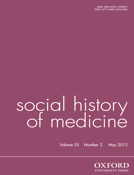-
Views
-
Cite
Cite
Sara Read, Irma Taavitsainen and Päivi Pahta (eds), Medical Writing in Early Modern English, Social History of Medicine, Volume 25, Issue 2, May 2012, Pages 550–552, https://doi.org/10.1093/shm/hkr157
Close - Share Icon Share
Extract
Many early-modern medical treatises share a number of rhetorical features, such as recourse to Latin or Greek in certain circumstances, or the regular claim that a particular medicine has a proven efficacy. Despite this, as the editors of Medical Writing in Early Modern English observe, ‘[t]he large field of medical writing in Early Modern English is still a fairly uncharted area from a linguistic point of view’ (p. xvii) and it is the lack of work on this topic that provides the impetus behind this collection. Contributors to Medical Writing are both medical historians and historical linguists because, as is becoming increasingly well understood across academia more broadly, ‘it is often at the interfaces between various disciplines where innovations are created by fusions of various ways of thinking and methodological triangulation’ (p. 2).
The investigations in this collection are mainly founded in the new database Early Modern English Medical Texts (EMEMT). This database is the second component of the Corpus of Early English Medical Writing, which is a three-part corpus of medical texts extending over the period 1375–1800. The sample under consideration in this edition consists of medical texts published between 1500 and 1700, and constitutes some two million words. In the present collection, essayists tend to use an appropriate sample section of the corpus typically containing 10,000 words. During this timespan vernacular medical texts came to supersede the number written in Latin, but more than this there was also a shift from logocentric medical learning, towards a more empirical scientific investigation of the ways that the body worked. As Turo Hiltunen and Jakka Tyrkkö comment ‘[t]he early modern medico was in many ways witness to, and a participant in, a profound shift in overall attitude to both sources and dissemination of knowledge’ (p. 45), which necessitated change and growth in the English language.




